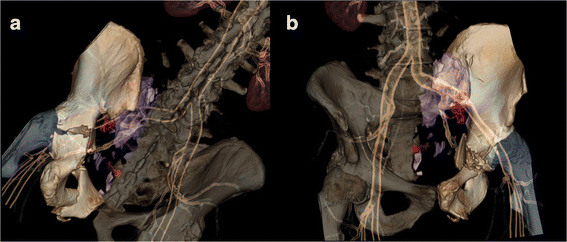Prognostic factors in endovascular treated pelvic haemorrhage after blunt trauma
- PMID: 28793885
- PMCID: PMC5551004
- DOI: 10.1186/s12893-017-0283-1
Prognostic factors in endovascular treated pelvic haemorrhage after blunt trauma
Abstract
Background: Angioembolization is the method of choice for treating haemorrhage after blunt pelvic trauma. The aim of this study was to determine technical factors related to endovascular procedures which might be related to patient outcome.
Methods: This retrospective study included 112 consecutive patients (40 women and 72 men; mean age 57.2 ± 20.0).
Results: There were age peaks at 43 and at 77 years. Patients over 65 years had mainly "low-energy" trauma; younger patients were more likely to have polytraumas. Younger patients were more severely injured and had more surgical interventions, larger haematoma volumes, lower Hb levels and required more transfusions than older patients. Women were older than men, had fewer surgeries and waited longer for an angiography (p < 0.05 each). Logistic regression analyses identified the injury severity score (ISS) as relevant for survival before age, haematoma volume and Hb. Propensity score analyses showed that in addition to the need for transfusions, haemoglobin, and haematoma volume, the length of the coils and the number of microcoils used were relevant (p < 0.05 each). The location of haemorrhage in peripheral parietal arteries (superior and inferior gluteal artery) was an influencing factor for re-angiographies, which were associated with considerably longer hospital stays of more than 40 days. Fewer particles had generally been used in these patients.
Conclusions: The use of too few coils and not using microparticles in angioembolization for pelvic haemorrhage are major influencing factors for the mortality or re-angiography rate. Special attention should be given to thorough peripheral embolization with microcoils, in particular for haemorrhage from the parietal branches of the internal iliac artery.
Keywords: Endovascular treatment; Haemorrhage; Pelvic trauma; Transarterial embolization.
Conflict of interest statement
Ethics approval and consent to participate
Due to the retrospective and observational design of this study ethical approval was waived by the Ethics Committee of the Medical University of Innsbruck following Austrian law.
Consent for publication
Not applicable.
Competing interests
The authors declare that they have no competing interests.
Publisher’s Note
Springer Nature remains neutral with regard to jurisdictional claims in published maps and institutional affiliations.
Figures

Similar articles
-
Endovascular Management of Severe Arterial Haemorrhage After Radical Prostatectomy: A Case Series.Cardiovasc Intervent Radiol. 2017 Nov;40(11):1698-1705. doi: 10.1007/s00270-017-1715-0. Epub 2017 Jun 7. Cardiovasc Intervent Radiol. 2017. PMID: 28593393
-
Pediatric abdominal and pelvic trauma: safety and efficacy of arterial embolization.J Vasc Interv Radiol. 2014 Feb;25(2):215-20. doi: 10.1016/j.jvir.2013.09.014. Epub 2013 Nov 16. J Vasc Interv Radiol. 2014. PMID: 24252774
-
Retroperitoneal packing or angioembolization for haemorrhage control of pelvic fractures--Quasi-randomized clinical trial of 56 haemodynamically unstable patients with Injury Severity Score ≥33.Injury. 2016 Feb;47(2):395-401. doi: 10.1016/j.injury.2015.10.008. Epub 2015 Oct 22. Injury. 2016. PMID: 26508436 Clinical Trial.
-
Arterial bleeding in pelvic trauma: priorities in angiographic embolization.Curr Probl Diagn Radiol. 2012 May-Jun;41(3):93-101. doi: 10.1067/j.cpradiol.2011.07.008. Curr Probl Diagn Radiol. 2012. PMID: 22459889 Review.
-
Evaluation and Management of Blunt Solid Organ Trauma.Tech Vasc Interv Radiol. 2017 Dec;20(4):230-236. doi: 10.1053/j.tvir.2017.10.001. Epub 2017 Nov 10. Tech Vasc Interv Radiol. 2017. PMID: 29224654 Review.
Cited by
-
Hockey: a pain in the butt! Isolated superior gluteal artery rupture following blunt pelvic trauma - an unusual case.Ann R Coll Surg Engl. 2021 Mar;103(3):e91-e93. doi: 10.1308/rcsann.2020.7045. Ann R Coll Surg Engl. 2021. PMID: 33645276 Free PMC article.
-
Transarterial embolisation is associated with improved survival in patients with pelvic fracture: propensity score matching analyses.Eur J Trauma Emerg Surg. 2021 Dec;47(6):1661-1669. doi: 10.1007/s00068-020-01497-9. Epub 2020 Sep 19. Eur J Trauma Emerg Surg. 2021. PMID: 32949247 Free PMC article.
-
Clinical outcomes of blood transfusion to patients with pelvic fracture in the initial 6 h from injury.Exp Ther Med. 2020 Mar;19(3):2252-2258. doi: 10.3892/etm.2020.8445. Epub 2020 Jan 10. Exp Ther Med. 2020. PMID: 32104291 Free PMC article.
References
MeSH terms
LinkOut - more resources
Full Text Sources
Other Literature Sources
Medical

